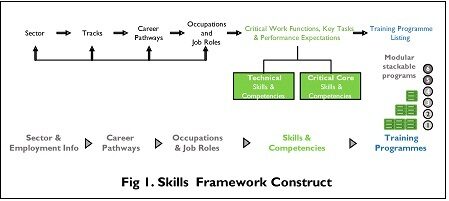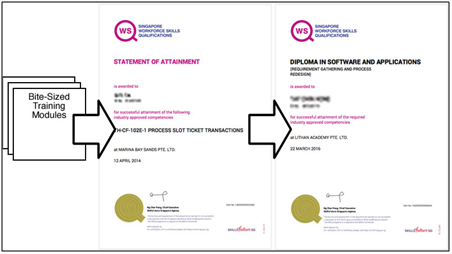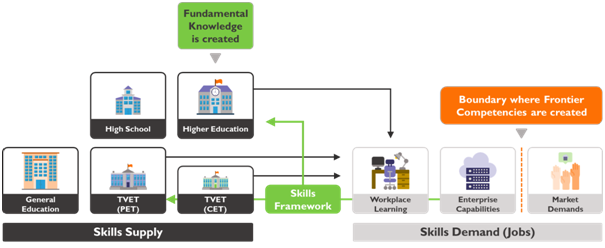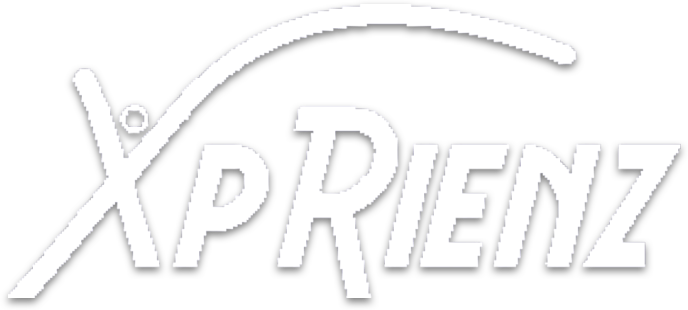Abstract
Skills are the new currency of the labor market (WEF 2019) and Skills are what carry the premium (The Minister for Education of Singapore, May 2017). When skills become the central currency of work, what will the future of work entail? The inability to attract the right talents remain among the leading barriers, with in-demand skill shortages being more acute in emerging industries.In reforming Singapore’s higher education, the Minister of Education for Higher Education and Skills (2018) envisioned thatInstitutes of Higher Learning should break out of their traditional mould, not only from being confined to education and changing the lives of students but broadened to drive innovation & enterpriseat work.
SkillsFuture Singapore (“SSG”) has, since 2016, developed the Skills Framework approach to skills development, which is co-created by the Employers, Industry Associations, Education Institutions, Unions and Government. This is to promote career development based on skills upgrading, mastery and lifelong learning. SSG also deployed big data and machine learning models to continually monitor the global, regional, and local jobs-skills trends to provide timely and relevant jobs-skills insights to guide the skills development journey. As the window of opportunity to reskill and upskill become shorter in newly constrained labor markets, can Skills Framework bridge Technical and Vocational Education and Training (“TVET”)to new and emerging Frontier Competencies?
Can Skills Framework Bridge TVET to Frontier Competencies?
I. Introduction
Singapore’s open economy and dependence on international trade has long meant that external global factors have a large impact on her businesses and workforce. With high reliance on human resource to drive economic growth, the country is committed to investing in continuous training for the workforce to ensure they remain responsive to evolving business needsand to provide a continuous talent pipeline to fuel future-focused businesses.Skills indicate demand and supply at a more nuanced level than occupations, whose required expertise and skills are changing increasingly rapidly, and qualifications, are often already outdated by the time they are obtained. Skills are the core currency of the labor market and hold the key to helping workers and employers to transit to emerging jobs of tomorrow. The current pace of change follows the direction of a skills-based, rather than a qualifications-based labour market, which is much more dynamic. Using skills as a variable of analysis provides a powerful tool in helping policymakers prepare for the future while building resilience in the present day (www.weforum,org).
Singapore’slabor force can be characterized as highly educatedbutrapidly aging residents’ workforce, which explains the country’s focus for continuing education. As the window of opportunity to reskill and upskill become shorter in today’s newly constrained labor market, moderating the pace of industrial policy change to allow deepening of skills and managing disruptive technologies to build an innovative workforce, has become an important TVET-related concern. Recent socio-economic changes have also resulted in further moves on the country’s Technical and Vocational Education and Training (“TVET”)policy.
The country’s dedication to lifelong education has attributed to Singapore SkillsFuture’s(“SSG”),a skills development-specific statutory board under the Ministry of Education (“MOE”),initiatives in developinga Skills Framework approach to skills development in 2016. The framework is co-created by the Employers, Industry Associations, Education Institutions, Unions and Government.The aim of the Skills Framework is to create a common skills language for individuals, employers, and training providers, to help facilitate skills recognition and to provide key information on sectors, career pathways, and occupations/job roles, as well as on existing and emerging skills required for the occupations/job roles. The framework also supports the design of training programs to build ‘deep’ skills for a lean workforce, enhance business competitiveness, and to support employment and employability.
Figure 1 below on the Singapore Skills Framework construct shows the inter-connection from a sector to the various training programmesfor a selected job role.
II. Development of Singapore’s TVET into the SkillsFuture’sinitiatives
Acomparison of academic, TVET (PET), and TVET (CET) in the Singaporean context is shown below.
|
Type of System |
Academic System |
TVET System |
|
|
Considerations |
PET |
CET |
|
|
Intent of System |
Foundational / Fundamental Knowledge Prepares the learner to be an active citizen |
Foundational / Fundamental Knowledge Prepares the learner to transit into the workforce |
Trains a person to be a better skilled and more productive worker |
|
Intent of Certification / Qualification |
Academic progression or mobility across levels |
Occupational transition or mobility |
Occupational/Career progression or mobility Recognition of competency (occupational requirement / licensure) |
|
Type of Learning Structure |
Institutional (mainly) |
Institutional (mainly) |
Industry (mainly) |
|
Profile of Learner |
Pre-employment Usually< 25 years old |
Pre-employment (mainly) Usually< 25 years old |
In-employment (mainly) or those in job transition Usually> 21 years old |
|
Basis for content design |
Syllabus-based (Curriculum designed from MOE / Institutional syllabus) |
Competency-based |
Competency-based (accredited Curriculum referenced from Skills Framework; non-accredited Curriculum referenced from industry standards) |
|
Role of Skills Framework |
Used for Career Guidance |
Used for Career Guidance and Curriculum Design |
Used for development of SSG accredited programmes Used as part of Progressive Wage Model, Career Counselling, Enterprise Human Capital Development, and other employment-related policies |
|
Nature of Learning |
Formal |
Formal (certifiable) |
Formal (for certifiable courses), non-formal and in-formal (for non-certifiable, but could be CPD-based) |
|
Examples of Training Institutions |
Primary, Secondary, Junior Colleges, Universities, Private Education Institutions |
Technical Sec Schools, ITE, Polytechnics, Universities |
IHLs (ITE, Polys, Universities), Professional Bodies, Accredited Private Training Providers, Public Training Institutions |
|
Examples of Certifications / Qualifications |
GCE O-Level, GCE A-Level, IB, Bachelor/Masters |
ITC, NITEC, Higher NITEC, Master NITEC, Diploma, Occupational Degrees |
WSQ Qualification, Diploma, ACCA, CFA |
|
Efforts on Industry Relevance |
Industry Orientation and Exposure (internships) |
Institution-Industry Collaborations; industry validated curriculum; Learn-Work Models; |
By-Industry-for-Industry frameworks; Agile and Proficiency-based curriculum and andragogy; Work-Learn or Work-based. |
Under the SSG initiatives, the IHLs have established lifelong learning centers to provide industry-relevant courses for adult learners and develop a responsive workforce development system to bring together synergies in CET and PET, so that skills requirements will continue to meet the demands of different sectors of the economy. IHLs have also referenced and aligned their TVET (PET) programmes to the framework to serve as a bridge for their students’ transition into the workforce and to ensure their students are job-ready and employable.

Since 2005, Singapore has a national credentialing (the Workforce Skills Qualification –“WSQ”) system, to train, develop, assess, and certify skills and competencies for the workforce. WSQ played an important role in Singapore’s CET landscape by promoting recognition of skills and competencies to facilitate progression, mastery and holistic development of the workforce through technical and generic skills.With the development of a Skills Framework in 2016, the WSQ credentialing system adopted the skills and competencies covered in the Skills Frameworks.
The Skills Framework provides up-to-date information to individuals to make informed choices on career development and skills upgrading, employers to design progressive human resource practices to recognize skills and make informed decisions on skills investment and recruitment, and the training providers to develop industry-relevant programmes to respond quickly to employers’ and individuals’ needs.
Figure 2 shows the Singapore Education System with the CET System. Note that the WSQ qualification systems (in the red box) is stand-alone, as the CET learners are markedly different from the PET learners, not in terms of cognitive capabilities, but in terms of availability, intention and motivation for learning.

Fig. 2. Singapore Education System with Continuing Education and Training System
Training programmes are delivered in ‘bite-sized’ modules to enable learning at the individual’s own pace. Upon completion of each module, a micro-credentialedStatement of Attainment (SOA) is awarded (see Figure 3below).

Fig.3. shows Different Levels of WSQ Qualifications
TVET (CET) uses proficiency levels to differentiate the different proficiency levels for individuals taking the course. Generally, the proficiency levels fall broadly into:
- Levels 1 and 2 – Operational Level (Entry level into an industry, irrespective of age)
- Level 3 – Supervisory Level
- Level 4 – Managerial Level
- Level 5 – Higher Managerial Level
- Level 6 – Management
An accumulation of 80% of the number of courses/modules under the same category and equivalent levels can lead to a qualification such as a diploma (see table below). The type and number of modules that lead to a qualification are indicated in the Skills Framework policy and this is determined by the total number of hours required to complete the curriculum.
To gain a full qualification, an individual must achieve all requirements in the specified number of credit values. Upon successful completion of each module, a Statement of Attainment (SOA) will be awarded. The table below shows the WSQ qualification levels under the TVET (CET) system.
Table 1 shows Diploma and Certificate by Level
WSQ Levels | Qualification Levels | Singapore Skills Framework (SSF) Levels | For Full Qualifications |
6 | Graduate Diploma (min CV= 15) | SSF Level 6 | Min. 5 modules, each 3 CV |
5 | Specialist Diploma (min CV= 15) | SSF Level 5 | Min. 5 modules, each 3 CV |
4 | Diploma (min CV= 20) | SSF Level 4 | Min. 7 modules, each 3 CV |
3 | Advanced Certificate (min CV=15) | SSF Level 3 | Min 5 modules, each 3 CV |
2 | Higher Certificate (min CV=10) | SSF Level 2 | Min. 5 modules, each 2 CV |
1 | Certificate (min CV=10) | SSF Level 1 | Min. 5 modules, each 2 CV |
Figure 4 below shows a group of Statements of Attainment SOAs to achieve the full qualification

Fig. 4. Accumulation of Relevant SOAs to Achieve the Full WSQ Qualification
Courses provided by the training providers can be WSQ or non-WSQ. However, only WSQ SSG-accredited courses are funded by the government and awarded with the WSQ certificates.
3. Responsiveness of the Skills Framework to the Labor Market
Singapore has alabor market information system (LMIS) which enables the country to quickly capture the situation for skills mismatch or skills gaps.Since 2016, SSG has been working with tripartite partners to identify sectoral skills needs to support industry transformation and new growth sectors. The thirty-four sectoral skills frameworks articulate the skills needs of the respective sectors for the next three years. To ensure that the workforce continues to receive timely and relevant jobs-skills insights to guide their skills development journey, SSG currently deploys big data and machine learning models to continually monitor the global, regional and local jobs-skills trends. A team of dedicated Jobs-Skills Analysts and Data Scientists work hand-in-hand with sectoral agencies to monitor changes in business models, operating models and deployment of technology that impact job content and skills needs. Data from the stock of global skills and local leadenterprises, job postings, training consumption and the global workforce’s curriculum vitae data, are synthesized to derive jobs-skills insights. These insights are further validated with global and local industry leaders and stakeholders, to produce fit-for-purpose insights for individuals, enterprises and training partners.
In addition, various surveysand research to capture information about skills demand on the ground with a wide coverage conducted on a regular basis through the official, detailed and methodically gathered Labor Market Information (LMI). There is also access to less official information or anecdotal LMI such as reports from local or international recruitment agencies to provide more information on on-demand skills.This is to enable the design of effective skills policy, from the data collated.
4. Frontier Competencies as Future Skills Currency
Frontier competencies are created by enterprises when they interface markets with cutting-edge products/services. While fundamental research uncovers new knowledge, frontier competencies bring such knowledge into market, or bring existing knowledge into new markets. These frontier competencies havea high degree of uncertainty of value as not all competencies can deliver what market needs. Examples of such competenciescomprise technical skills; cross-sector skills such as human capital and business development skills; and also, critical core skills such as critical thinking and analysis as well as problem-solving; and newly emerging skills in self-management such as active learning, resilience, stress tolerance and flexibility.
Figure 5 below shows 9 levels of Technological Readiness to illustrate the process and challenges that hinders innovation and readiness in adoption of new technologies and competencies to bring to an emerging market.

Fig. 5. Concept of Technology Readiness Levels
Level 1-4 activities from basic research to proof of concept to validation conducted in laboratories:
1) Basic Principles Observed and reported
2) Technology Concept and/or Application Formulated
3) Analytical and experimental critical function and/or Characteristic Proof-of-concept
4) Component Validation in a laboratory Environment
Level 5-7 on technology development to facilitate transition from a simulated environment to creating a prototype in a realistic environment:
5) Component validation in a simulated environment
6) Systems/Subsystem model or prototype demonstrated in a simulated environment
Level 7-9 Prototyping and system development to bring product/services to the real world or industry:
7) System prototype demonstration in an operational environmentB
8) Actual Technology completed through tests and demonstrations
9) Actual Technology proven through successful use in an operational environment
Frontier competencies are usually created from Level 4 onwards, in which entrepreneurs and enterprises attempt to bring new products from the concept phase to the market.
5. Bridging TVET to Frontier Competencies with Skills Framework
The content and delivery of education has long been challenged as beingoutdated for the needs of today’s economies and societies, with the pandemic creating new disruptions (WEF Annual Report 2020).Together with changing industry trends, technology adoption and new business models, work processes and job functionscan be affected and this in turn changes the content and skills profile of existing jobs, as well as creation of new jobs. In his address to the ST Education Forum 2022entitled “Definition of success in Singapore education system must change” (Ng, Feb 2022), the Education Minister, Mr Chan, said the education system needs to shorten the time to market for skills and knowledge, adding that there must be faster movement from frontier research, leading industrial technology and breakthrough market practises to academia and back to the market.To achieve this, he added, “the education system must sharpen its approach to internships, academia and industrial collaborations, as well as alumni engagement”.
Figure 6 below shows the concept of supply and demand of skills. Skills Framework as indicated actsas askills ontology to bridge the supply of skills by CET and higher education,to the capabilities of the enterprises to meet skills demand forthe new markets. The challenges faced are not only with the rampant changes in technology but confronting barriers to bring such new products to meet market demands, and that would require new competencies.

Fig. 6. Concept of Skills Supply and Demand
Barriers in adopting frontier competencies to meet market demands may be due to a list of reasons such as mismatch between information needs and availability; the ability of companies to harness the growth potential of new technology; the confidence level of leaders to deliver business results and maximise shareholders’ value; the right combination of skills and expertise may not always be available in emerging professions, and finally, the challenge in the ability to attract the right talent or skills to emerging markets. These reasons are a common feature of any potentials to transform to a new footing, opening doors to new approaches and learning new ways of thinking and doing, as such venturesmight involve high costsandface high risk of failure.Historically, capital, raw materials and labor have been considered more valuable than creating and applying knowledge. In this digital age,knowledge plays a key role in information revolution. Although a large majority of employers do recognize the value of human capital investment, their major challenges are to select the ‘right’ insights from numerous sources and transform them into useful knowledge. Employers need to find ways to enable their organisations acquire, measure, teach, share, apply and manage the knowledge, otherwise valuable human and knowledge resources will be wasted.
Tacit knowledge, embedded and synthesized in employees’minds has oftenbeen underutilized or lost through resignations, outsourcing, downsizing, mergers and terminations. Employers need to devise ways to balance the use of tacit skills and explicit knowledgeto improve the understanding and effectively use the new knowledge and skills presented to them. Organizations must begin to create worker-centered environments to encourage open sharing to transform the tacit knowledge and skills to explicit, and also develop means to document these explicit knowledge and skills.
In an economy where the only certainty is uncertainty, the one sure source of lasting competitive advantage is competencies. When markets shift, technologies proliferate, competitors multiply, and products become obsolete almost overnight, successful companies are those that consistently create new competencies, disseminate them widely throughout the organization, and quickly embody them in new technologies and products (Nonaka, 1991).
III. CONCLUSION
In the era of rapid labor market challenges, as represented by Covid-19 and geopolitical and environmental issues, the importance of skills on economic growth and survival is never to be understated.The impact of upskilling on economic growth shows how Singapore’s approach to funding national upskilling initiatives and policies in the development of skills across geographies and sectors can reshape economies.Although greater investment on time and resources is needed to have more accurate LMIS, a skill frameworkcan serve as a bridge to harness frontier competencies for sustainability and to strengthen TVET competitiveness. However, a high degree of agreement among the authorities, unions, enterprisesand the industry are necessary to determine what upskilling or reskilling is required for the students or the workforce. And it is the choices made by policymakers, business leaders, workers and individuals that help lay the foundations of a new narrative and practical approach to job creation, labor market forecasting and analysis, and new standards for work in the new economy (The Future of Jobs Report 2020).Enhancingthe current TVET system to better respond to industry needs might be one of the more obvious priorities for TVET policy not only for Singapore but it is also a concern worldwide. Therefore, using a Skills Framework to reinforce structured workplace programs,(not as an auxiliary agenda to coursework such as co-op internships, and providing consulting services to employers), can help increase the use of the LMIS and strengthen the versatility of all programmes to respond to accelerating industrial and technological changes.
The Singapore government has demonstrated a high degree of commitment to allocating necessary resources in upskilling and reskilling the workforce, manage LMI regularly and comprehensively, facilitate continuous collaboration among the government, labor unions, employers, and training providers. Ultimately, it is still important for any organisationintending to work in any emerging or frontier market, to take the time to fully understand the exact context, complexities, nuances, and dynamics prevailing,to capitalise andstrive in these fast growth areas.Organizations that dominate emerging technologies exhibit a collective sense of identity and a shared understanding of what they stand for and where they are going.
• https://www.weforum.org/whitepapers/strategies-for-the-new-economy-skills-as-the-currency-of-the-labour-market/related/
• https://www.skillsfuture.gov.sg/skills-framework
• https://www.skillsfuture.gov.sg/NewsAndUpdates/DetailPage/5ed87fff-39df-4dc3-b63b-6f2763db6aa9
• https://www.enterprisejobskills.gov.sg/content/resources/211221_EPJS_SSG%20Skills_Demand_for_the_Future_Economy_2021.pdf
• https://www.straitstimes.com/singapore/parenting-education/definition-of-success-in-singapore-education-system-must-change-chan-chun-sing
• https://www3.weforum.org/docs/WEF_Future_of_Jobs_2020.pdfhttps://www.weforum.org/reports/the-future-of-jobs-report-2020
• https://www.weforum.org/reports/the-future-of-jobs-report-2020
• https://www.associationofmbas.com/how-to-succeed-as-a-leader-in-emerging-and-frontier-markets/
• WEF_Future_of_Jobs_2020.pdf
• Manuscript_REHVA_valley_JHRLMAMK.pdf
• The role of tacit and explicit knowledge in the workplace – Elizabeth A. Smith
• HBR – The Knowledge-Creating Company byIkujiro Nonaka
Anderson Tan,
Director, Biipmi Pte. Ltd.
anderson@biipmi.com
Anderson Tan is a serial entrepreneur, serial angel and corporate investor, as well as a Practicing Management Consultant equipped with a Master of Arts in Lifelong Learning, Diploma in Adult and Continuing Education and Master of Engineering. Owning and managing several SkillsFuture Singapore (“SSG”) Registered Training Provider (“RTP”), Anderson is knowledgeable in entrepreneurialism, adult learning frameworks and is effective in analyzing, designing, developing, implementing, and evaluating learning, employability and HRD solutions in organizations and with individuals.
Anderson also has extensive expertise in Business-Training Consulting. This includes the development of Enterprise-wide Training Plans, organization accreditation for SSG RTP status, and Curriculum Development (OJT and WSQ). He is also a key driver in the internationalization of the Singapore skills system, with interests in Philippines, Vietnam, Indonesia, India and Myanmar. Anderson is currently the Lead Consultant in developing the Philippine Skills Framework (PSF) covering sectors such as Logistics, Digital Animation, Games Development; and cross-sector frameworks such as Business Development, Operations and Productions Management, Human Capital Development, and Business Development.
Co-Author
Goh Hin Lan
TVET Curriculum Specialist
hinlan.g@gmail.com
Goh Hin Lan is a certified Singapore Management Consultant for Human Capital Development, an Adult Educator, Workplace Learning Specialist and a Career Coach. Hin Lan possessesa Master of Arts in Lifelong Learning, Diploma in Adult and Continuing Education and Master of Business Administration. A Workplace Skills Qualification (WSQ) facilitator, she has delivered Train-the-Trainers modules to equip Trainers in the delivering and development of WSQ modulesand has designed modules using the Singapore Skills Framework.
Hin Lan is currently the Principal Curriculum Consultant,in providing training to develop curriculum using the Philippine Skills Framework for the Philippine civil service and academia.
1/ International Conference of 25th Anniversary of Hồng Đức University on 23 Sept 2022
Theme: Local Economic and Social Development in the post-Covid 19 era
2/ 2022 East and Southeast Asia
UNEVOC Network Consolidation Workshop
Theme: Beyond New Normal, Towards the Transition: TVET for Resilience
On September 28 – 29, 2022
3/ THAILAND FUTURE SKILLS SUMMIT 2022
On 12 October 2022

